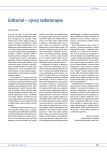The Assessment of Quality of Life of Patients at Oncological Clinic – Pilot Study
Authors:
R. Bužgová 1; E. Hajnová 1,2; D. Feltl 2,3
Authors‘ workplace:
Ústav ošetřovatelství a porodní asistence LF UO v Ostravě
1; Onkologická klinika FN Ostrava
2; Ústav zobrazovacích metod LF OU v Ostravě
3
Published in:
Klin Onkol 2013; 26(6): 404-408
Category:
Original Articles
Overview
Backround:
In oncological care the main emphasis should not be put only on prolonging a patient’s life, but also on its quality. The aim of the study was to assess the quality of life of patients hospitalized at the oncology clinic of the University Hospital of Ostrava (UHO), who exhausted all the anti‑cancer treatment options.
Patients (sample) and methods:
In a pilot study the sample consisted of 93 patients from the oncological clinic of UHO with Karnofsky score < 60. A questionnaire EORTC QOL‑ C30 was used to evaluate the quality of life.
Results:
The overall score of quality of life was 49%. Repeated measurement showed a significant decrease of the score to 37% (p < 0.001). Assessing the quality of life on a functioning scale, role functioning (47.3; 95% CI 42.6– 52.1) and social functioning (48.0; 95% CI 42.5– 53.5) were assessed the worst. When judging on a symptoms scale, patients reported the major problem was fatigue (48.8; 95% CI 44.8– 52.8) and pain (44.5; 95% CI 39.2– 48.8). Repeated measurement showed a statistically significant decrease in quality of life on the scale of functioning in all areas. On the symptoms scale there was similarly a decline of quality in fatigue, pain and breathlessness categories (p < 0.01). Furthermore, we observed a correlation between lower overall quality of life and a worse level of physical functions (r = 0.8047), social relationships (r = 0.7796), fatigue (r = 0.8166) and pain intensity (r = 0.8282).
Conclusion:
Palliative care patients admitted to the oncology clinic perceive their quality of life as inferior. Home palliative care or a hospice appears to be a more suitable environment for the management of terminal care.
Key words:
palliative care – quality of life – medical oncology
This study was supported by grant of Internal Grant Agency of the Czech Ministry of Health No. NT 13417-4/2012 IGA MZ ČR.
The authors declare they have no potential conflicts of interest concerning drugs, products, or services used in the study.
The Editorial Board declares that the manuscript met the ICMJE “uniform requirements” for biomedical papers.
Submitted:
15. 5. 2013
Accepted:
9. 6. 2013
Sources
1. Slováček L, Priester P, Kopecký J et al. Paliativní onkologická péče v systému poskytování zdravotní péče v Královéhradeckém kraji: vlastní zkušenosti. Klin onkol 2011; 24(4): 265– 270.
2. Pastrana T, Junger S, Ostgathe C et al. A matter of definition – key elements identified in a discourse analysis of definitions of palliative care. Palliat Med 2008; 22(3): 222– 232.
3. Girgis A, Johnson C, Currow D et al (eds). Palliative Care Needs Assessment Guidelines. The Centre for Health Research and Psycho‑ oncology. Newcastle: University of Newcastle 2006.
4. Haškovcová H (ed.). Fenomén stáří. 2. vyd. Praha: Havlíček Brain Team 2010.
5. Pearce CM, Duffy A. Holistic care. In: Lugton J, McIntyre R (eds). Palliative care – the nursing role. 2th ed. London: Elsevier 2005: 63– 90.
6. Gourdji I, McVey L, Purden M. A quality end of life from a palliative care patient’s perspective. J Palliat Care 2009; 25(1): 40– 50.
7. Haškovcová H (ed.). Thanatologie. 2 vyd. Praha: Galén 2007.
8. Fayers PM, Aaronson NK, Bjordal K et al. The EORTC QLQ‑ C30 Scoring Manual. 3rd ed. Brussels: EORTC Quality of life Group 2001.
9. Johnsen AT, Petersen MA, Pedersen L et al. Symptoms and problems in a nationally representative sample of advanced cancer patients. Pall Med 2009; 23(6): 491– 501.
10. Bretscher M, Rummans T, Sloan J et al. Quality of life in hospice patients. Psychosomatics 1999; 40(4): 309– 313.
11. Jordhøy MS, Fayers P, Lage JH et al. Quality of life in palliative cancer care: results from a cluster randomized trial. J Clin Oncol 2001; 19(18): 3884– 3894.
12. Bužgová R, Havelková K. Zjišťování potřeb terminálně nemocných v hospicové péči. Cas Lek Cesk 2012; 151(4): 190– 195.
13. Peters L, Sellick K. Quality of life of cancer patients receiving inpatient and home‑based palliative care. J Adv Nurs 2006; 53(5): 524– 533.
14. Svidén A, Fürst CJ, von Koch L et al. Palliative day care – a study of well‑being and health‑related quality of life. Palliat Med 2009; 23(5): 441– 447.
15. Křivohlavý J (ed.). Psychologie nemoci. 1. vyd. Praha: Grada 2002.
16. Vágnerová M (ed.). Psychopatologie pro pomáhající profese. 4. rozš. a přepr. vyd. Praha: Portál 2008.
17. Špatenková N (ed.). Krizová intervence pro praxi. 1. vyd. Praha: Grada 2004.
18. Bužgová R, Macháčková G. Hodnocení potřeb terminálně nemocných v domácí péči: pilotní studie. Prakt Lék 2012; 92(2): 111– 116.
Labels
Paediatric clinical oncology Surgery Clinical oncologyArticle was published in
Clinical Oncology

2013 Issue 6
Most read in this issue
- Syndrome of Vena Cava Obstruction in Oncology
- Is Preoperative Bone Scintigraphy in Early Stage of Breast Cancer T1N0 Indicated and Meaningful?
- Smoking and Breast Cancer
- The Assessment of Quality of Life of Patients at Oncological Clinic – Pilot Study
